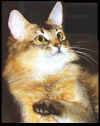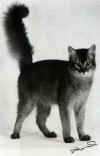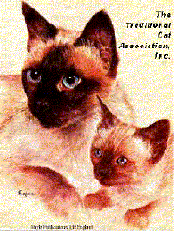|
Departments
eBook now Available!
|
Exclusive - THE book on Traditional & Classic
Siamese cats

Written by the Founder of TCA, Inc.
Tullycrine
Affordable
Web Design
|
|
|
The TRADITIONAL
SOMALI©® CAT FAQs
By Diana Fineran,
Copyright June 20, 2000
|
 |
Click on pictures
to enlarge |

|
Q: What is the History of the Traditional Somali?
A: Simply put, the Traditional Somali is a long-haired Traditional Abyssinian
with the appeal of a fun-loving and active short haired cat, but with a long
coat. Its full tail gave them the nick name, "fox cat." It has the
luxurious look of a long haired breed, but without the troublesome grooming that
comes with a Persian. It has the same "wild look" and personality as
the Traditional Abyssinian.
The Traditional Somali is a smoothly balanced, medium sized cat with solid
muscular development. A medium-long body sports a medium length, soft and silky
coat, that requires little grooming. One to three inches long, the coat has
shorter fur across the shoulders. A fluffy, full tail and tufts between the toes
compliment its gorgeous appearance. Adding to this is a ticked or agouti coat
with four to twenty bands of color on each hair. The ticked coat creates an
aura, which is harmonized by a blending solid color on its underside. Somali’s
have small litters of three to four, and the kittens mature slowly. Full size is
reached at about eighteen months of age.
Through the research I did, exact proof as to how or where the long-haired
gene got into the Traditional Abyssinian breed was not made available. Perhaps
it is a naturally-occurring long-hair gene that many of our accepted breeds
have. Occasionally long-haired kittens were born to Traditional Abyssinian
parents, so when speaking about the Traditional Aby an equal heritage belongs to
the Traditional Somali. For the history of the Traditional Abyssinian, please
refer to the Traditional Abyssinian section on our Home Page. In any case, the
Traditional Somali came to the fore in the cat world in 1979, when it was
accepted and began to be shown in various cat associations. The campaigning in
that year was done by Ruth and Bob Morris and Patricia Nell Warren.
Genetic research indicates Traditional Abyssinians descended from a breed
found in Southeast Asia and the coast of the Indian Ocean. Therefore, it is not
a created breed, but a natural breed. It resembles the African Wildcat (Felis
silvestris lybica), originally widespread in Africa, Europe and Western Asia and
thought to be the progenitor of all domestic cats. The African Wildcat has been
identified as one of the species mummified by the Egyptians during the time of
the cat cult in that country. However, their true origins are lost in the
obscurity of unrecorded history.
During World War II the Abyssinian breed was out-crossed to Russian Blues to
save the breed. This introduced the blue coloration. To bring back the
"original" Traditional Somali, TCA, Inc. does not recognize blue or
fawn as naturally-occurring colors.
The first breeders of Somalis were Mrs. Evelyn Mague and Patricia Nell Warren
in the U.S. In Europe the first Somali breeders were Mrs. Jutta Broisch,
Cologne/Germany and Dorothea Rupprath-Kroeger of Burchana Cattery, Germany, who
specialized in Black-Silver Somalis.
The change (some call it the decline) in the Traditional Somali began in or
around 1983, when the other cat associations began supporting a far more
extreme, tubular, thin, cat with an extreme wedge-shaped head. Reports came from
breeders saying, "In all countries the Somali has changed and been terribly
weakened by inbreeding." Perhaps British and Scandinavian Traditional
Somali's are our best hope for a return of the Traditional Somali. At recent
shows a FULL GROWN Extreme Wedge Somali, was more like a kitten, no more than 6
to 7 pounds (male!). A good adult Traditional Somali should have considerable
weight for its size. A tail that is too short is another common fault. The faces
of modern Extreme Wedge Somali's are also "whisker-pinched" and narrow
and too fine boned, like the Extreme Wedge Siamese have become. My research
revealed new problems in the extreme of the breed: renal amyloidosis, luxated
patellas, retinal atrophy and some weird kind of anemia! These genetic
weaknesses did NOT exist in the Traditional Somali. As long as inbreeding is
continued, the breed will only get worse."
The Traditional Somali goes through the usual two seasonal sheds, but other
wise shed very little. Less, in fact, than other short haired breeds. A daily
brushing is not required as in other long haired breeds, yet it is more for
affection than a requirement. Their hair does not mat, although the longer fur
on their hindquarters needs attention from time to time.
Q: What is the health of the Traditional Somali?
A: Health wise, the Traditional Somali has few genetic defects. The only
references to any medical problems were about some bloodlines that are prone to
gingivitis. Veterinary monitoring and feeding large portions of a high-quality
dry food helps this problem. It has been noticed that a very few lines develop
late-onset kidney disease, which usually manifests itself around age 8. This is
quite rare, however. Some have a mild kind of digestive trouble or delicate
digestion, causing them trouble with hair-balls. Giving hair-ball remedies can
easily eliminate this problem.
By Diana Fineran,
Copyright June 20, 2000
|
|
|

 The
Traditional Cat Association,
Inc.©1987®TM
Official Website
The
Traditional Cat Association,
Inc.©1987®TM
Official Website

